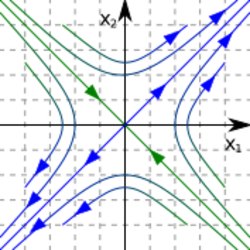Hyperbolic equilibrium point
In the study of dynamical systems, a hyperbolic equilibrium point or hyperbolic fixed point is a fixed point that does not have any center manifolds. Near a hyperbolic point the orbits of a two-dimensional, non-dissipative system resemble hyperbolas. This fails to hold in general. Strogatz notes that "hyperbolic is an unfortunate name—it sounds like it should mean 'saddle point'—but it has become standard."[1] Several properties hold about a neighborhood of a hyperbolic point, notably[2]
- A stable manifold and an unstable manifold exist,
- Shadowing occurs,
- The dynamics on the invariant set can be represented via symbolic dynamics,
- A natural measure can be defined,
- The system is structurally stable.
Maps
If [math]\displaystyle{ T \colon \mathbb{R}^{n} \to \mathbb{R}^{n} }[/math] is a C1 map and p is a fixed point then p is said to be a hyperbolic fixed point when the Jacobian matrix [math]\displaystyle{ \operatorname{D} T (p) }[/math] has no eigenvalues with a zero real component.
One example of a map whose only fixed point is hyperbolic is Arnold's cat map:
- [math]\displaystyle{ \begin{bmatrix} x_{n+1}\\ y_{n+1} \end{bmatrix} = \begin{bmatrix} 1 & 1 \\ 1 & 2\end{bmatrix} \begin{bmatrix} x_n\\ y_n\end{bmatrix} }[/math]
Since the eigenvalues are given by
- [math]\displaystyle{ \lambda_1=\frac{3+\sqrt{5}}{2} }[/math]
- [math]\displaystyle{ \lambda_2=\frac{3-\sqrt{5}}{2} }[/math]
We know that the Lyapunov exponents are:
- [math]\displaystyle{ \lambda_1=\frac{\ln(3+\sqrt{5})}{2}\gt 1 }[/math]
- [math]\displaystyle{ \lambda_2=\frac{\ln(3-\sqrt{5})}{2}\lt 1 }[/math]
Therefore it is a saddle point.
Flows
Let [math]\displaystyle{ F \colon \mathbb{R}^{n} \to \mathbb{R}^{n} }[/math] be a C1 vector field with a critical point p, i.e., F(p) = 0, and let J denote the Jacobian matrix of F at p. If the matrix J has no eigenvalues with zero real parts then p is called hyperbolic. Hyperbolic fixed points may also be called hyperbolic critical points or elementary critical points.[3]
The Hartman–Grobman theorem states that the orbit structure of a dynamical system in a neighbourhood of a hyperbolic equilibrium point is topologically equivalent to the orbit structure of the linearized dynamical system.
Example
Consider the nonlinear system
- [math]\displaystyle{ \begin{align} \frac{dx}{dt} & = y, \\[5pt] \frac{dy}{dt} & = -x-x^3-\alpha y,~ \alpha \ne 0 \end{align} }[/math]
(0, 0) is the only equilibrium point. The Jacobian matrix of the linearization at the equilibrium point is
- [math]\displaystyle{ J(0,0) = \left[ \begin{array}{rr} 0 & 1 \\ -1 & -\alpha \end{array} \right]. }[/math]
The eigenvalues of this matrix are [math]\displaystyle{ \frac{-\alpha \pm \sqrt{\alpha^2-4}}{2} }[/math]. For all values of α ≠ 0, the eigenvalues have non-zero real part. Thus, this equilibrium point is a hyperbolic equilibrium point. The linearized system will behave similar to the non-linear system near (0, 0). When α = 0, the system has a nonhyperbolic equilibrium at (0, 0).
Comments
In the case of an infinite dimensional system—for example systems involving a time delay—the notion of the "hyperbolic part of the spectrum" refers to the above property.
See also
- Anosov flow
- Hyperbolic set
- Normally hyperbolic invariant manifold
Notes
- ↑ Strogatz, Steven (2001). Nonlinear Dynamics and Chaos. Westview Press. ISBN 0-7382-0453-6. https://archive.org/details/nonlineardynamic00stro.
- ↑ Ott, Edward (1994). Chaos in Dynamical Systems. Cambridge University Press. ISBN 0-521-43799-7. https://archive.org/details/chaosindynamical0000otte.
- ↑ Abraham, Ralph; Marsden, Jerrold E. (1978). Foundations of Mechanics. Reading Mass.: Benjamin/Cummings. ISBN 0-8053-0102-X.
References
 |


